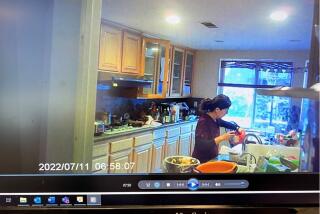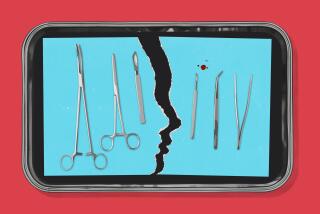N.J. tanning bed mom: Tanorexic? Or victim of a witch hunt?
The case of the New Jersey woman accused of taking her young daughter into a tanning bed and letting her burn appears to be raising a question for many people. The question isn’t: Did she or didn’t she? The question is: Could this woman be a tanorexic?
Patricia Krentcil, 44, pleaded not guilty earlier this week to child endangerment charges for allegedly putting her daughter in a Nutley, N.J., tanning bed. (Some reports say the girl is 5, others say she’s 6.) Krentcil told TMZ that she’s become the victim of a witch hunt.
Images of Krentcil have appeared in various online and TV news reports, all of them showing her with extremely -- surprisingly -- burnished skin.
PHOTOS: New Jersey tanning bed mom in courtHer husband, Rich, defended his wife in the New York Daily News: “She didn’t do anything wrong, and it’ll be proven in court.”
He also told the paper that his wife uses makeup to make her skin even darker, which might explain why her booking photo bears little resemblance to her appearance in court Wednesday.
The case has led many media watchers to call Krentcil a “tanorexic.” That term is sometimes used to jokingly describe Hollywood types who can’t step onto the red carpet without sporting a sun-kissed glow, whether it comes from a spray-on tanning salon, the beach or a tanning bed.
But “tanorexic” is also used to describe a far more serious and potentially deadly condition -- an addiction to tanning.
Only a personal physician can say whether Krentcil is a “tanorexic” -- psychologically dependent on a fix that only a tanning session can provide. But Dr. Richard Glogau, a clinical professor of dermatology at UC San Francisco, told the Los Angeles Times that this much is clear:
“She’s over done it.... She’s used up a lot of her skin’s ability to withstand UV rays. She’s drained the bank.”
The case is raising awareness about the dangers of tanning beds, which use extended exposure to UVA and UVB radiation to darken the skin. Extended UV radiation can cause deadly skin cancer, warns the American Academy of Dermatology.
Nonetheless, tanning-bed revenues topped $2.6 billion in 2010, thanks to the more than 27 million Americans who sought that sun-kissed glow at their local strip mall instead of the beach.
For the record, the American Academy of Dermatology Assn. opposes indoor tanning and supports a ban on the production and sale of indoor tanning equipment for nonmedical purposes.
That’s not likely to happen anytime soon -- indoor tanning is too popular. But some states have moved in that direction by banning minors from using tanning beds or requiring them to get parental permission.
Glogau urged parents to stand firm and not allow their children to tan. He likened the dangers to allowing a child to sit in the front seat of a car without a safety belt.
Granted, the legal allegations and health implications are probably not the reasons for the frenzied media coverage of the case. When the incident became public, the media pounced on basic juicy elements such as the words “New Jersey” and “tanning beds.” Together, they conjured up images of the Oompa Loompa-hued Snooki and her “Jersey Shore” castmates.
But then the world got a look at Krentcil -- who admits she frequently visits a tanning salon -- and folks nearly came undone.
Glogau said that if Krentcil came to see him, he would order her to stop tanning altogether -- and to immediately begin using sunscreen. Then he’d keep a close eye on her skin for any sign of skin cancer, followed by topical medical therapy.
ALSO:
Cabin full of frozen cows? Grab a saw and get to work
Florida Gov. Rick Scott won’t limit guns outside the GOP convention
Cleveland bomb plot: 5 now face weapon-of-mass-destruction charge
rene.lynch@latimes.com
Join Rene Lynch on Google+, Facebook or Twitter
More to Read
Start your day right
Sign up for Essential California for news, features and recommendations from the L.A. Times and beyond in your inbox six days a week.
You may occasionally receive promotional content from the Los Angeles Times.







